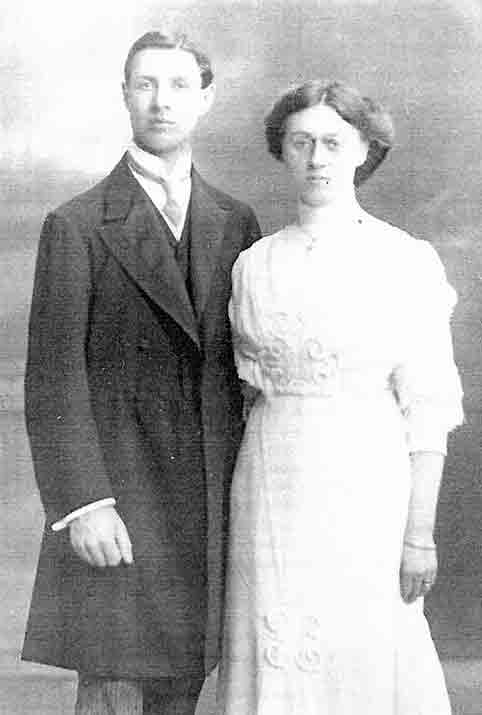And the Bride Wore…
Author: Linda-May Ballard
Date: 2001
Source: Ullans: The Magazine for Ulster-Scots, Nummer 8 Hairst 2001
Linda-May Ballard, Curator of Textiles, UFTM

The costume collection at the Ulster Folk and Transport Museum (MAGNI) includes the wedding dress of Jane Eliza Sprott, who on 18 January 1912 married Samuel Smith Corbett, in Portadown. When the dress was donated to the museum collection, it was accompanied by a wedding photograph of the bride and groom, always a useful asset when documenting a bride’s outfit. Together, the dress and photograph provide important insights into the expectations and aspirations of a comfortably provided shop keeper and his bride, and when an exhibition on local marriage traditions opened at the museum early in the 1990s, both dress and photograph featured in the display. Conservation and preparations of the dress for exhibition revealed a telling detail about contemporary taste, confirming that while the dress is of rayon, a synthetic material, the lining is of silk. Manmade material had only just become available, and this reversal of the order that might be taken for granted today shows us that the contemporary attitude to the new synthetics must have been to wear them with pride, and in pride of place, with natural fabrics consigned to a humbler role! It is of particular interest that a draper’s bride should make this choice, especially for her wedding dress, which would be expected to be the focus of considerable attention and comment. It may be deduced that rayon was a new addition to the stock carried by her husband’s business, and that her choice was likely to influence and promote sales of the new fabric!

JANE ELIZA SPROTT AND HER BRIDEGROOM
in their wedding attire which is very typical of the late Edwardian period. (Photograph: copyright Ulster Folk & Transport Museum)
The bride’s dress is very fashionable, and in exactly the style popular at the end of the Edwardian era. It features elegant appliqué motifs, and these too are likely to have been available from her husband’s business establishment. The feature appliqué worn on the skirt suggests that this is hobbled (ie that a tie passes from back to front between the knees, restricting movement) but in fact this is not the case. The placement of the motif suggests acquaintance with this fashion coupled with a practical reluctance actually to wear the real and rather limiting thing! It is worth remembering that it is only comparatively recently that a wedding dress became a garment to be worn only on the wedding day, and Mrs Corbett is likely to have worn her gown on many occasions subsequent to her marriage. She appears to have had equal appreciation of fashion and of ease of movement, especially in a dress that must have made an important addition to her wardrobe.
The dress and photograph were graciously donated to the UFTM by the bride’s daughter, who also knew that a Margaret Maconachie made the dress. Very recently, further information about Miss Maconachie has come to light, courtesy of a member of her family. Family history reveals that Miss Maconachie was born in Kilfinan, Argyll on September 14, 1863. She was the first of four children born to John (originally from County Antrim) and Margaret (nee Johnson, originally from Belfast). By 1865, the family must have moved to Glasgow, where another daughter and two sons were born, the last in 1869. At some point they returned to Ireland, and by 1901 the children and their widowed father were resident in Portadown. At this stage, Miss Maconachie was apparently employed in manufacturing underwear, and she may have combined this occupation with dressmaking, or perhaps graduated to dressmaking at some time between 1901 and 1912. Family history also suggests that later in the twentieth century she worked as a dressmaker in Bangor, County Down.
Margaret Maconachie’s story is another illustration of the close cultural and historical links between Ulster and Scotland, the more worth telling because the contribution of the dressmaker to the fabric of the past all too often goes unsung. A dressmaker needed to be skilled with her needle, competent to draw patterns and to adapt these to fit her client, capable of cutting fabric economically and to good effect, have an artistic eye, flair and the ability to keep up to date with changing trends and fashions. Miss Maconachie was sufficiently skilled to enable her to produce for a discerning client an important dress that would have been conspicuously displayed. Making the wedding gown for a draper’s bride marks her out as talented and reliable, while her life story establishes her as an Ulster woman of Scottish birth. Her abilities must have been well appreciated by her clients, and must have had an untold impact on their contemporaries, for dress is a code through which messages are constantly exchanged between wearer and witness. The wedding dress of Jane Eliza Sprott is therefore a very important historical artefact, distilling these messages from the past and preserving them for the future.
I am very grateful both to Jean Corbett and to Joan Ramsey for their generosity and help in ensuring that this dress is so well documented.
Next: An Ulster-Scotch Postcaird
Previous: The Gaelic Archipeligo
Contents: Ullans: The Magazine for Ulster-Scots, Nummer 8 Hairst 2001

